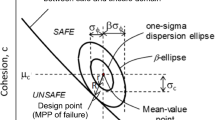Abstract
This paper discusses the development and application of two alternative strategies, in the form of global and sequential local response surface (RS) techniques, for the solution of reliability-based optimization (RBO) problems. The problem of a thin-walled composite circular cylinder under axial buckling instability is used as a demonstrative example. In this case, the global technique uses a single second-order RS model to estimate the axial buckling load over the entire feasible design space (FDS), whereas the local technique uses multiple first-order RS models, with each applied to a small subregion of the FDS. Alternative methods for the calculation of unknown coefficients in each RS model are explored prior to the solution of the optimization problem. The example RBO problem is formulated as a function of 23 uncorrelated random variables that include material properties, the thickness and orientation angle of each ply, the diameter and length of the cylinder, as well as the applied load. The mean values of the 8 ply thicknesses are treated as independent design variables. While the coefficients of variation of all random variables are held fixed, the standard deviations of the ply thicknesses can vary during the optimization process as a result of changes in the design variables. The structural reliability analysis is based on the first-order reliability method with the reliability index treated as the design constraint. In addition to the probabilistic sensitivity analysis of the reliability index, the results of the RBO problem are presented for different combinations of cylinder length and diameter and laminate ply patterns. The two strategies are found to produce similar results in terms of accuracy, with the sequential local RS technique having a considerably better computational efficiency.
Similar content being viewed by others
References
Ayyub, B.M.; McCuen, R.H. 1997: Probability, statistics, and reliability for engineers, pp. 404–408 . Boca Raton: CRC Press,
Bucher, C.G.; Bourgund, U. 1990: A fast and efficient response surface approach for structural reliability problems. Struct. Saf. 7, 57–66
DOT – Design Optimization Tools (V. 5.0) 1999, Vanderplaats R&D, Inc.
Freund, T.J.; Littell, R.C. 2000: SAS System for Regression, 3rd edn, pp. 68–77. Cary: SAS Institute
Hasofer, A.M.; Lind, N. 1974: An exact and invariant first-order reliability format. J. Eng. Mech. 100, 111–121
Jaunky, N.; Knight, N. 1999: An assessment of shell theories for buckling of cylindrical panels. Int. J. Solid Struct. 36, 3799–3820
Liaw, L.D.; DeVries, R.I. 2001: Reliability-based optimization for robust design. Int. J. Veh. Des. 25, 64–77
Liu, Y.W.; Moses, F. 1994: A sequential response surface method and its application in the reliability analysis of aircraft structural systems. Struct. Saf. 16, 39–46
Madson, H.O.; Krenk, S.; Lind, N.C. 1986: Methods of structural safety, pp. 120–123. New Jersey: Prentice-Hall
NESSUS (V. 7.0) 2002, Southwest Research Institute
Polykin, A.A.; van Keulen, F.; Toropov, V.V. 1995: Optimization of geometrically nonlinear thin-walled structures using the multipoint approximation method. Struct. Optim. 9, 105–116
Rackwitz, R.; Fiessler, B. 1978: Structural reliability under combined random load sequences. Comput. Struct. 9, 489–494
Sevant, N.E.; Bloor, M.I.G.; Wilson, M.J. 2000: Aerodynamic design of a flying wing using response surface methodology. J. Aircr. 37, 562–569
Shinozuka, M. 1983: Basic analysis of structural safety. J. Struct. Div. ASCE 109, 721–740
Stroud, A.H.; Secrest, D. 1963: Approximate integration formulas for certain spherically symmetric regions. Math. Comput. 17, 105–135
Torng, T.Y.; Lin, H.-Z.; Khalessi, M.R. 1996: Reliability calculation based on a robust importance sampling method. In: Proc. 37th AIAA/ASME/ASCE/ AHS/ASC Structures, Structural Dynamics, and Materials Conference (held in Salt Lake City, UT), pp. 1316–1325
Toropov, V.V.; Filatov, A.A.; Polykin, A.A. 1993: Multiparameter structural optimization using FEM and multipoint explicit approximations. Struct. Optim. 6, 7–14
VisualDOC – Design Optimization Software (V. 3.0) 2002, Vanderplaats R&D, Inc.
Wu, Y.-T. 1994: Computational methods for efficient structural reliability and reliability sensitivity analysis. AIAA J. 32, 1717–1723
Zhou, J.-H.; Nowak, A. 1988: Integration formulas to evaluate functions of random variables. Struct. Saf. 5, 267–284
Author information
Authors and Affiliations
Corresponding author
Rights and permissions
About this article
Cite this article
Rais-Rohani, M., Singh , M. Comparison of global and local response surface techniques in reliability-based optimization of composite structures. Struct Multidisc Optim 26, 333–345 (2004). https://doi.org/10.1007/s00158-003-0353-0
Received:
Revised:
Published:
Issue Date:
DOI: https://doi.org/10.1007/s00158-003-0353-0




